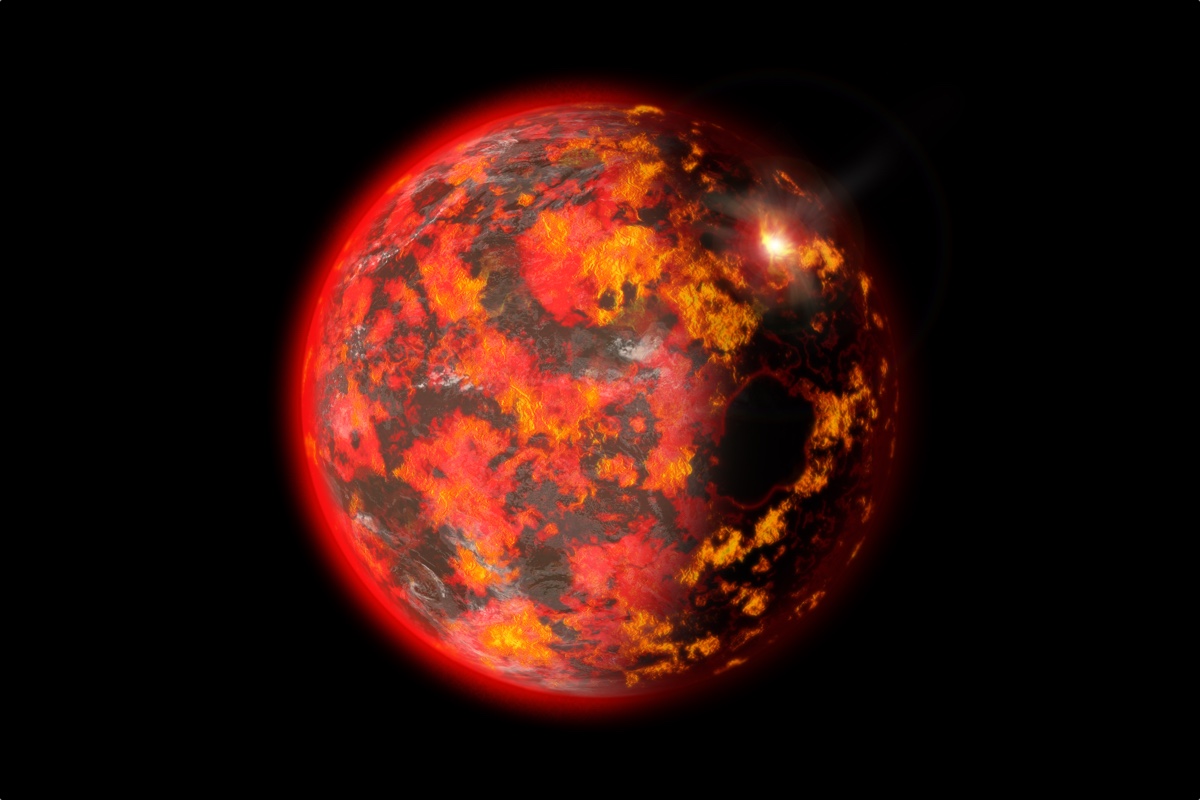Early Earth's Spin Helped Shape Its Molten Magma Ocean

The early Earth was an infernal place: hot, roiling, rapidly rotating and bombarded by space debris, including a Mars-size body whose impact created the moon.
That same impact also turned the entire surface of the newly formed Earth into a molten magma ocean. Now, new research finds that the rapid spin of the planet may have influenced how this molten sea cooled.
The speed of the Earth's rotation may have affected where the mineral silicate crystallized and settled as the magma ocean solidified, the new study found. The uneven accumulation of silicate and other minerals may have influenced the start of plate tectonics or might even help explain the weird composition of today's mantle, said Christian Maas, a geophysicist at the University of Münster in Germany. [In Photos: Ocean Hidden Beneath Earth's Surface]
Hot Earth
Maas is the lead author of the new study exploring how the ancient magma ocean cooled and the minerals within it crystalized. Those processes all started about 4.5 billion years ago, not long after Earth formed, when a planetary body the size of Mars slammed into the newborn planet. The impact knocked off a chunk of debris that formed the moon, while also creating so much heat that Earth's surface became an ocean of magma several thousand miles deep.
"It's really important to know how the magma ocean looked," Maas told Live Science. As that hot sea cooled, it set the stage for all the geology that would come next, including plate tectonics and the planet's modern-day layered, mantle-and-crust arrangement.
One thing not many researchers have considered, Maas said, is how Earth's rotation would have affected the cooling. Using a computer simulation, Maas and his colleagues addressed that question, modeling the crystallization of one type of mineral, silicate, which makes up a big chunk of Earth's crust. [The Strangest Places on Earth (Photos)]
Cooldown
The simulation showed that the speed of the planet's rotation affected where the silicate settled in the early stages of the magma ocean's cooling, which probably happened over a thousand to a million years. With slow rotation, in the range of 8 to 12 hours per revolution, the crystals stay in suspension, remaining evenly distributed throughout the magma ocean.
Get the Space.com Newsletter
Breaking space news, the latest updates on rocket launches, skywatching events and more!
As the speed of rotation increases, the distribution of the crystals changes. With moderate or high speed, the crystals quickly settle to the bottom at the North and South poles and move to the bottom half of the magma ocean near the equator. At the middle latitudes, the crystals stay suspended and are evenly distributed.
At the very fastest rotation speeds — a full rotation in around 3 to 5 hours — the crystals accumulate at the bottom of the magma ocean no matter the latitude. However, convection in the roiling magma near the polar regions repeatedly caused the crystals to bubble up, so the crystallized layer was not very stable.
Scientists don't know exactly how fast the early Earth rotated, though they estimate it spun around completely in about 2 to 5 hours at the time of the magma ocean's existence.
The study, published in the upcoming May issue of the journal Earth and Planetary Science Letters, didn't consider other types of minerals or model the silicate distribution beyond the first phase of the magma ocean's crystallization. Adding other mineral types into the model is the next step, Maas said.
He added that he's also interested in studying later planetary impacts. Not long after the giant, moon-forming impact, the Earth probably got hit with smaller space rocks, Maas said. If the rotation of the Earth was making the magma ocean crystallize unevenly, the minerals in those chunks of interstellar debris could have been incorporated into Earth very differently depending on where they landed, he said.
It's also not clear whether today's mantle retains traces of this fiery beginning. The modern mantle is a bit of a mystery. Particularly bewildering are "the blobs," two continent-size areas of hot rock that always slow down any seismic waves from earthquakes that pass through. Properly known as "large low-shear-velocity provinces," or LLSVPs, these blobs are each 100 times the height of Mount Everest, but no one knows what they're made of or why they're there.
There are a lot of dots still unconnected between today's mantle anomalies like the blobs and the ancient magma ocean of early Earth, Maas said. Perhaps all traces of that fiery sea have long been erased by geologic forces, he added. But figuring out what the initial solid surface of the planet looked like could help explain how it evolved to its current state.
- Photos: The World's Weirdest Geological Formations
- Way to Be Weird, Earth: 10 Strange Findings About Our Planet
- Photo Timeline: How the Earth Formed
Originally published on Live Science.
Join our Space Forums to keep talking space on the latest missions, night sky and more! And if you have a news tip, correction or comment, let us know at: community@space.com.

Stephanie Pappas is a contributing writer for Space.com sister site Live Science, covering topics ranging from geoscience to archaeology to the human brain and behavior. She was previously a senior writer for Live Science but is now a freelancer based in Denver, Colorado, and regularly contributes to Scientific American and The Monitor, the monthly magazine of the American Psychological Association. Stephanie received a bachelor's degree in psychology from the University of South Carolina and a graduate certificate in science communication from the University of California, Santa Cruz.










